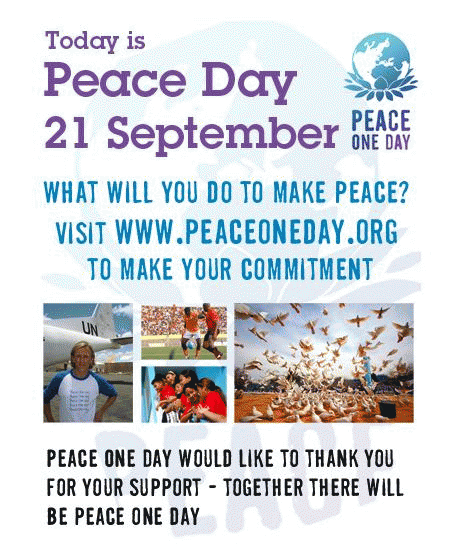"I could see peace instead of this." --Lesson 34 of A Course in Miracles.
The first time I'd arrived at that lesson, and focused on it for the day, back in 1987, was also the day I went to a performance of a Greek tragedy, and on top of the angst of the play, there was my own stirring upset about someone I'd hoped to meet there not showing up. I learned I had to make a conscious choice about seeing Peace.
Today is September 21, the International Day of Peace, recognized by the United Nations. The organization, Peace One Day, has been inviting participation by making personal commitments to take action on Peace Day ("anything from saying sorry to organising a live event. The scale of your action is not important � ��" your willingness to act is everything.").
On a larger scale, they also suggest a "One Day One Goal" football or soccer match on this day, or a screening of Jeremy Gilley's film "The Day After Peace", available for viewing today at the Y ouTube screening room.
In honor of Peace Day, on Friday, September 18th, there was a ceremony at the United Nations, which included presentations by UN dignitaries and UN Messengers of Peace Jane Goodall and Princess Haya of Jordan, video-conferencing with students in Iraq, The Democratic Republic of the Congo, Liberia and Sudan, a presentation of Pledges for Peace, the Minute of Silence, and the Ringing of the Peace Bell by UN Secretary-General Ban Ki-Moon.
The UN Secretary General then spoke: "As you know, I just rang the Peace Bell. I think you saw a broadcast of my remarks. These can be summarized in three words: We Must Disarm."
This is what today is about. Disarmming.
On every level of our lives, we face this same challenge. To see Peace instead of engaging in Tragedy. To Disarm instead of Clashing.
We who are writers and activists spend much of our energy spreading the word about the tragic truths we have discovered. And we are right to do so. Absolutely.
But we must also seek the healing solutions, and share those as well.
To that end, I must point out two wonderful sources which encourage me.
The first is Karen Armstrong, who I first saw last March on Bill Moyer's Journal. In 2008, her work in field of writing and talking about the connections between the world's great religions, and her mission to shine a light on compassion and the universal Golden Rule, brought her the $100,000 TED Prize,with which she has joined forces with an international Council of Sages to create the Charter for Compassion.
Listen to her on Bill Moyers, and at TED Talks, and see what her thinking does to heal the disastrous conflicts between religions.
The second is Walter Cronkite, yes, the "most trusted man in America". In 2005, he sat down to interview Dennis Kucinich about his plan to create a U.S. Department of Peace. What happened in that interview revealed even more about Cronkite than it did Kucinich. It became clear that all those decades of intense awareness of the world's conflicts brought him to the conclusion that it was time for the United States to focus on Peace.
(Note: You can view every article as one long page if you sign up as an Advocate Member, or higher).





